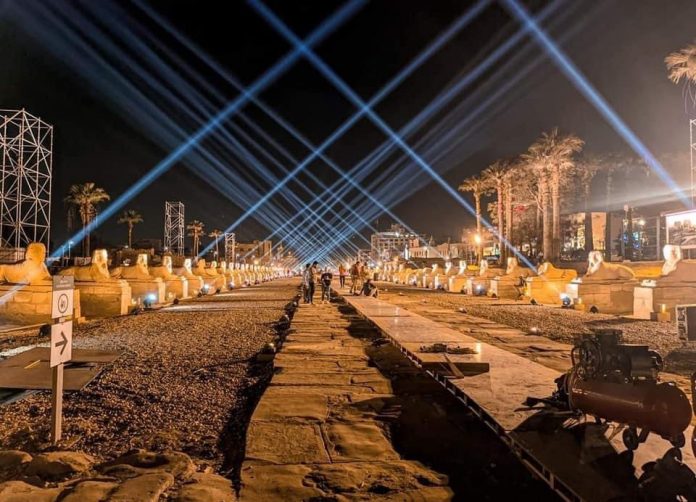Rams Road Celebration: The Path of God. It tells the Egyptian story of Thebes, the capital of ancient Egypt, in the governorate of Luxor.
The Rams Road Celebration: The Path of God. It tells the Egyptian story of Thebes, the capital of ancient Egypt, in the governorate of Luxor.
Luxor is preparing for the great worldwide celebration of the “Renaissance of the Rams Road”. The Egyptian Ministry of Tourism and Archeology, which has just announced the date of November 25, 2021 for the launch of this new place of discovery.
The intensive preparations and visits are carried out and led daily by Dr Khaled El-Anany, Egyptian Minister of Tourism and Archeology for whom said: “The ceremony must be a legendary celebration worthy of the name, value and of Egyptian history, which emerged in the heart of Thebes, the capital of ancient Egypt, in the governorate of Luxor ”.

“The project enjoys the support of the Egyptian state, and of President Abdel Fattah El-Sisi,” Dr Mustafa Al-Saghir, director general of the archaeological sites of Karnak and general supervisor of the road, told the media.
Luxor, nicknamed the City of the Hundred doors or the City of the Sun, is formerly known as Thebes. It is located on the banks of the Nile, which divides it into two halves, belonging to the fourth nome of Upper Egypt, on the eastern shore of the Nile, the Valley of the Kings facing it on the other shore.
At the same time, the temples of Karnak and the temple of Luxor are also preparing for this event, with in particular the finalization of replicas of a certain number of boats according to the figures and hieroglyphs which appear on the monument of these buildings
These boats which will parade on the waters of the Nile, will participate in the celebration of the ancient “Festival of the Opet”, “heb nefer en Ipet”, during which the Amun-Rê of Karnak, accompanied by his wife Mut and their son Khonsu, were carried in procession to Luxor, where he took the form of Amon-Min.
It was then one of the most sumptuous religious festivals in Pharaonic Egypt. Originally, the festivities lasted eleven days, but ended up spanning almost a month under the Ramessides.
Many other scenes have been immortalized on the columns of these sanctuaries and that can still be seen, despite the past centuries.
The “Rams Road” also called “the Alley of Rams”, which stretches over 2700 meters, will henceforth link the temples of Karnak and Luxor. It wore in the past the name of “Amon in Opet” (Amon on the horizon).
The procession of November 25, will be that of modern times. It will also be that of new technologies.
At all times, Egyptian temples have been built according to a rite that was to embody and reflect the path of the the sun’s lord through the sky.
Rams Road covers the 2700 meters that separate the two jewels of ancient Thebes, the temple of Luxor to the south and that of Karnak to north , thus becoming a new historic path.
It will be on each side embellished with 1200 large statues,with rams or sphinx heads which symbolize the god “Amon”.
This gigantic project took several years to see the light of day. The last months of construction required titanic work on the part of the teams involved in the project.
Lately the procession of royal mummies from the Egyptian Museum of Tahrir, including 22 former rulers of Egypt, and 4 rulers went to join the new National Museum of Egyptian Civilization in Fustat.
Recently the procession of royal mummies of the Egyptian Museum of Tahrir, including 22 ancients sovereigns of Egypt, and 4 ancients sovereigners went to join the new National Museum of Egyptian Civilization in Fusat.
The beginning of soft power political strategy for Egypt and Cairo, which are rely on all these world events to develop tourism structures, to revive tourism in the country and to promote modern Egypt. The ancient Egyptians who once called this road “Wat Nathr”, the path of God, Luxor has now become the largest open-air museum in the world today.
🌇 #مشاريع_مصر🇪🇬|
— مشاريع مصر Egypt (@EgyProjects) November 25, 2021
الألعاب النارية تضيء سماء مدينة الأقصر في احتفالية افتتاح #طريق_الكباش
Fireworks light the sky over Luxor’s Avenue of Sphinxes #SphinxAvenue #ThisIsEgypt pic.twitter.com/7Pdh2AXBrT
- Le site du ministère du Tourisme et de l’Archéologie: http://www.antiquities.gov.eg/DefaultAr/Pages/default.aspx
- Le site de l’office du tourisme égyptien : http://egypt.travel/fr
🌇 #مشاريع_مصر🇪🇬|
— مشاريع مصر Egypt (@EgyProjects) November 25, 2021
Luxor is gearing up to host a glamorous ceremony to reopen the 2,700-metre-long Avenue of Sphinxes that links the Ancient Egyptian temples of Luxor and Karnak, today at 7:30 PM. pic.twitter.com/lBEkA09ppR
A voir aussi sur artsixMic :
Une escapade arty sur la Côte de Granit Rose
Morzine, une destination chaleureuse de qualité
Au coeur du Wadi Rum, le Yasmina Luxury Camp !
Voyage en Equateur avec Elizabeth Rojas Gilliand
La ville-état de Singapour : La ville-jardin !
Vichy : La reine des villes d’Eaux !
Savoie Mont Blanc : Cet hiver, c’est ouvert !
Joyau du Pacifique Sud : la Nouvelle-Calédonie !
Novi Sad capitale européenne de la culture 2022
l’Astrotourisme sous les étoiles de La Palma
Le MiL8 : La Montagne Autrement !
Balade en Indonésie : A la découverte de Bali
Un été Arty à Mandelieu-La Napoule
l’Hôtel Littéraire Jules Verne : Hommage à l’écrivain
Le Château de Kerjean présente : En Terre inconnue ? Le monde au 15e siècle !
Les Cali Sisters présentent leur nouveau restaurant : le Cali UPTOWN
3ème édition du Festival des Jardins de la Côte d’Azur : Jardins d’Artistes !
























